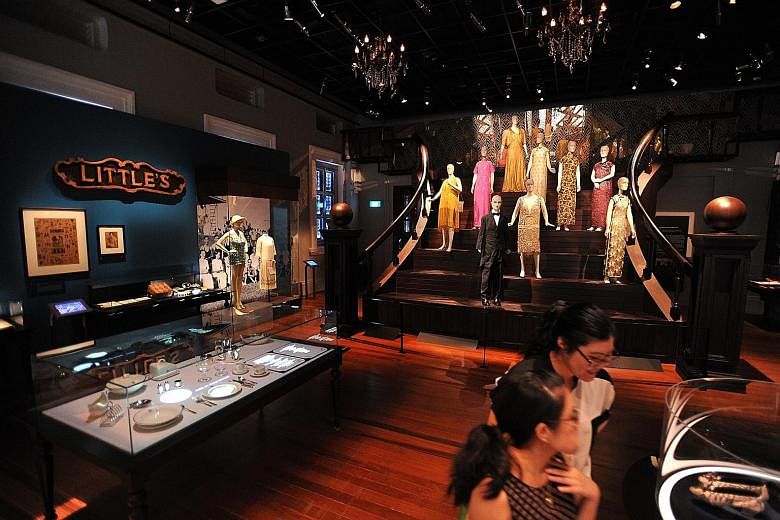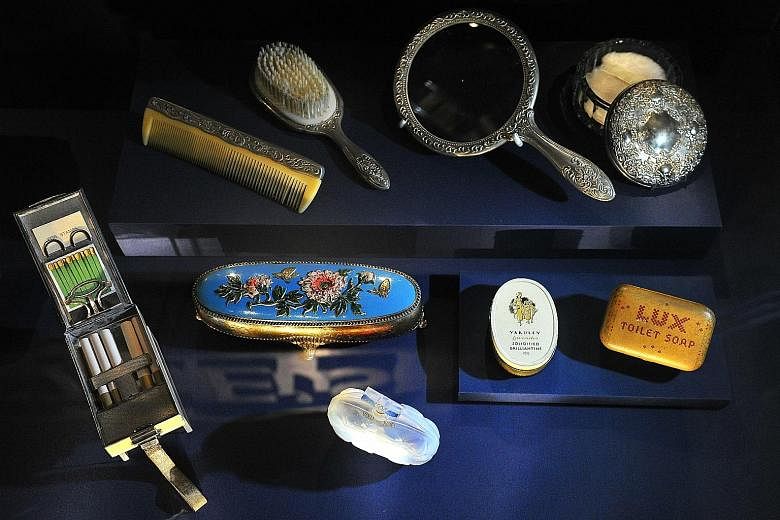REVIEW / MUSEUM
NATIONAL MUSEUM OF SINGAPORE'S PERMANENT GALLERIES
That a 128-year-old museum dedicated to centuries worth of history needed to revamp its galleries just eight years after its last major renovation speaks of the times.
The National Museum of Singapore had undergone a three-year, $132-million refurbishment and expansion in 2003 and reopened in 2006. Then last year, it closed all its permanent galleries for an extensive makeover.
In the eight years between, the museum had welcomed a new director, made it free for Singaporeans to enter its permanent galleries and won new visitors through events it hosted, such as popular weekend markets that sell crafts, fashion and food.
In the same time, the world changed too; swipes on a digital screen became the language of intimacy and the duration of human connection became measured in seconds over mobile chat applications.
Against this evolving cultural landscape, which includes the opening of swish museums such as the upcoming National Gallery Singapore, the country's oldest museum needed to stay fresh, attractive and relevant.
-
VIEW IT/NATIONAL MUSEUM OF SINGAPORE'S PERMANENT GALLERIES
-
WHERE: 93 Stamford Road
WHEN: 10am to 7pm daily
ADMISSION: Free for Singaporeans and permanent residents, $10 (adults), $5 (students and seniors aged 60 and above)
INFO: Go to www.national museum.sg for details of free guided tours of the Singapore History Gallery
After an almost year-long makeover of its permanent galleries, the grand dame has emerged from the revamp shy of a reinvention, but having made headway in its push to stay relevant.
The Singapore History Gallery retains much of its former rooms and content, but it also has new artefacts and remodelled sections on Singapore's post-Independence period, and its portable audio guides have been replaced with listening stations located throughout the gallery. Its entrance has also moved from a spiral ramp that began on level 2 to new sliding doors on level 1, where the interactive video wall by artist Matthew Ngui used to be. (The ramp is closed for the installation of a new interactive, multimedia work and will reopen in the second quarter of next year.)
The four Living Galleries - dedicated to food, fashion, film and photography - have been completely made over. The new galleries, known collectively as Life In Singapore: The Past 100 Years, and individually as Modern Colony, Surviving Syonan, Growing Up and Voices Of Singapore, focus on the way of life during different periods of time.
The revamp, importantly, has given the museum a chance to respond to its free admission policy by making its exhibits more accessible to a wide range of audiences. What this demands is not a reductivist approach, but a skilful unpacking of the past so it is easily understood and enjoyed by both heritage enthusiasts and neophytes. And the museum has worked towards this.
The display of pre-19th century pottery shards, which anchors the opening section of the history gallery, comes with labels that detail the significance of individual pieces of earthenware as well as the larger socio-economic climate that influenced their production, circulation and use. This helps the uninitiated see a world in grains of fired sand and feeds the minds of history buffs.
The Surviving Syonan gallery also makes history accessible without over-simplification. One might wonder about the museum's emphasis on World War II - several sections of the history gallery are also dedicated to this period - but there is no doubting that this gallery's assemblage of wartime sales receipts, work permits, cake moulds and love letters (of the paper and ink variety) inspires double takes and rumination on how love, life and business carried on in a time of extreme hardship.
But the museum misses the mark, too, at times.
Critically, the revised history gallery is no longer organised as a double-pronged route, with an events path that follows major historical developments and a personal path that traces accounts of history by individuals. While the merits of splitting the gallery along historical and personal narratives are debatable, removing this curatorial device without reworking the content - and instead adding more artefacts to it - makes it difficult for the visitor to navigate the sprawl.
The makeover has also given the museum, which has done well in getting the public through its doors for events, a chance to charm a crowd into exploring Singapore's past.
The Voices Of Singapore gallery is a welcoming space; the still-fluffy carpet is singularly uplifting. But the exhibit, which sets out to look at how Singapore's cultural identity took shape amid rapid industrialisation and economic growth in the 1970s and 1980s, is less exhilarating.
The museum chooses to flesh out this topic through the performing arts, which is by nature ephemeral. The endeavour is admirable, but the result - a display that includes show posters, admission tickets and oral history recordings, fails to adequately capture the depth of the issue.
More perplexing are the two installations commissioned for this gallery, a wall of televisions and a room staged like a drive-in cinema. Both installations stream ad nauseam advertisement-like videos of popular leisure and tourist spots in the 1970s and 1980s, but fail to reinforce the connection, if any, between the sites and Singapore's cultural identity.
This millennial language of digital mash-ups is also used in the commissioned art installation at the end of the history gallery. The work projects Singapore icons, including images of social campaign mascots and blocks of Housing Board flats, onto a landscape of white boxes. The result, however, is mostly visual diarrhoea.
The museum's decision to make history speak the language of today by commissioning works that respond to Singapore's past is astute. But its plan fizzles when the works fail to offer new, meaningful experiences of history.
The Modern Colony gallery, which is as intelligent as it is resplendent, points the way forward.
The photogenic gallery loosely borrows the setting of a colonial bungalow to show how men who ruled the front-of-house and public sphere in the roaring 1920s lived, dressed and worked. But retreat into the "bungalow" and sumptuous tableaus, including a sweeping stairway parading female mannequins in evening wear, will suck you into the progressive world of women in Singapore in the 1920s and 1930s. The artefacts bring to life an era when women's dressing became less prohibitive, education for girls became increasingly common and women could become financially independent.
History is not embarrassed about being old. When a museum dedicated to the subject recognises its timeless appeal and celebrates it without contrivance, the museum will find itself with the power to connect with the masses.


